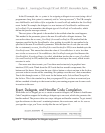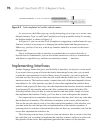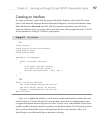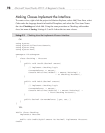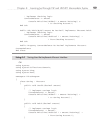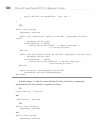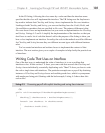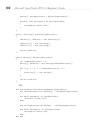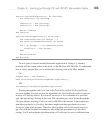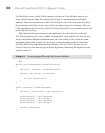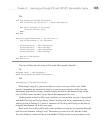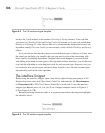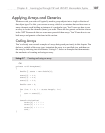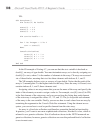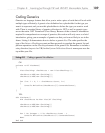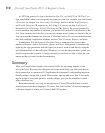
Chapter 4: Learning Just Enough C# and VB.NET: Intermediate Syntax 103
Function GetCheckingAccounts() As Checking()
Dim chkAccts(1) As Checking
chkAccts(0) = New Checking()
chkAccts(1) = New Checking()
Return chkAccts
End Function
Function GetSavingsAccounts() As Saving()
Dim numberOfAccounts As Integer = 5
Dim savAccts(numberOfAccounts) As Saving
For i As Integer = 0 To numberOfAccounts
savAccts(i) = New Saving()
Next
Return savAccts
End Function
To save space, I haven’t included the entire application in Listing 4-5, which is
available with the source code for this book via the McGraw-Hill W
eb site. To understand
how it works, imagine that you’ve written the following code in the Main method:
C#:
Program bank = new Program();
bank.ProcessPayrollForCheckingAndSavingAccounts();
VB:
ProcessPayrollForCheckingAndSavingAccounts()
Walking through the code, let’s start at the ProcessPayrollForCheckingAndSaving
Accounts method. You can see how the algorithm calls GetCheckingAccounts to retrieve
an array of Checking objects. If you recall, an array is a list of elements of a specified
type, that type being Checking in this case. The algorithm goes on to iterate through the
Checking objects, invoking Credit on each to add 500 to the account. Some employees
want their paychecks in Checking, but others might want their paychecks to go into
Saving (or some other account). Therefore, the algorithm calls GetSavingsAccounts to
get a list of those accounts for employees who want their paychecks to go into their
savings. You’ll notice that the algorithm inside of GetSavingsAccounts is different from



